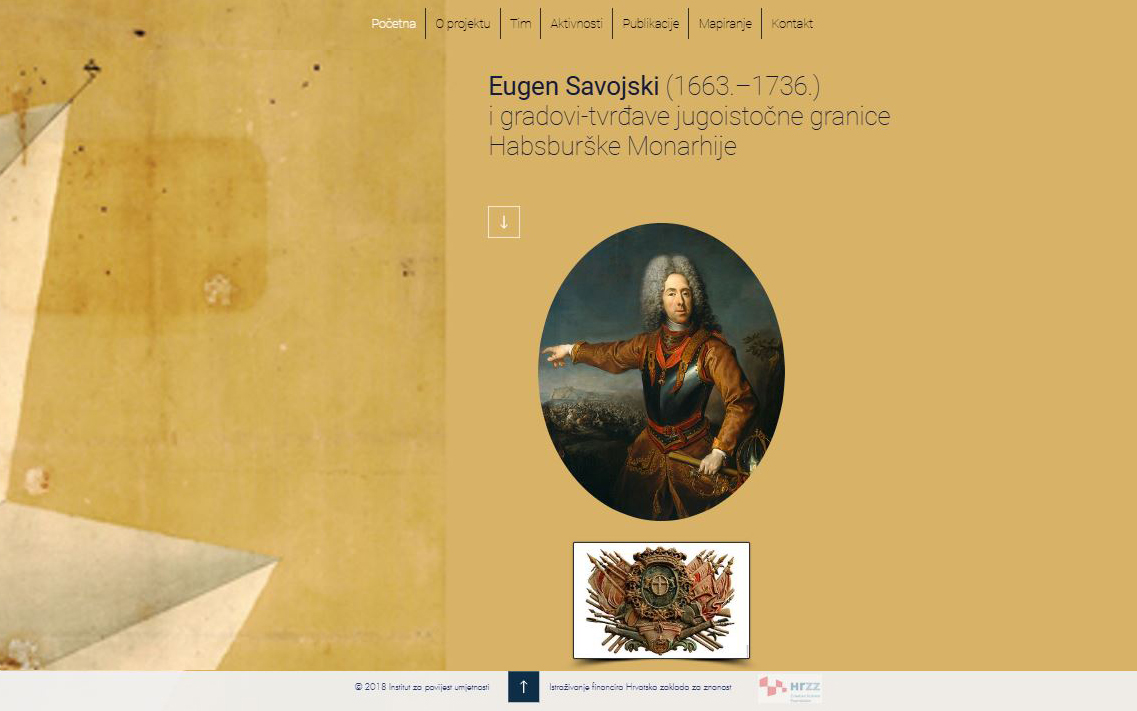Eugene of Savoy (1663–1736) and Fortress-Towns on the South-Eastern Border of the Hapsburg Monarchy
Project duration: 2018-2022
Principal investigator
Katarina Horvat-Levaj, PhD
Associates
Andrej Žmegač, PhD
Ratko Vučetić, PhD
Margareta Turkalj Podmanicki, PhD
Petar Puhmajer, PhD
Vlasta Zajec, PhD
Milan Pelc, PhD
Radoslav Tomić, academician
Zlatko Uzelac
Ivana Haničar Buljan, architect
Consultants
Vladimir Marković, academician
Ivana Horbec, PhD
Dubravka Đukanović, PhD
About the project
The liberator of the eastern parts of the Hapsburg Monarchy from the Ottoman Turks, Prince Eugene of Savoy (1663–1736), in addition to his brilliant military career, was also initiator of important town-planning and architectural undertakings. One the one hand, his building activities concerned the construction of his own residences in the capital city and various parts of the Monarchy. Thanks to his choice to employ one of the most important Baroque architects – Johann Lucas von Hildebrandt (1668–1745) – to design most of his mansions and palaces, the Prince’s residences, and in the first place Belvedere in Vienna, became a turning point in the development of Central-European High and Late Baroque. The second segment of his building activities, which the Prince headed as the President of the Imperial War Council, concerned fortress-towns along the new boundary with the Ottoman Empire. They were built based on the knowledge of a strategic genius, they were not just the application of the most modern bastion structures but also contain Baroque ambiences of high urbanistic and architectural quality.
The strategic position of today’s eastern Croatia in the context of the former Austrian-Ottoman border resulted in some of the most imposing fortified towns being in the Croatian territory - Osijek, Slavonski Brod and Stara Gradiška – and Petrovaradin makes up an indivisible whole with them. Although the formation of most of the fortress-towns had begun before Prince Eugene’s era, and continued after him, it was the Prince of Savoy that gave them a key signature. By engaging top military engineers, border fortresses and their fortification systems are on par with the projects of the most famous European fortress builder - Vauban (1633-1707). At the same time, by including leading state architects in designing the main public and religious buildings within the fortified rings, Croatian architecture was here enriched by some anthological examples of Baroque. The importance of the fortress-towns mentioned above in pushing the border further south and east inspired the creator of these activities to build a private fortified manor near Bilje, where we also find many innovations of Viennese architecture of that time.
Since this theme has not been fully explored in the national context, and the international scientific public knows hardly anything about it, the aim of this project is to explore the urbanism and architecture of Osijek, Slavonski Brod, Stara Gradiška, Petrovaradin and Bilje, and evaluate them in the context of Eugene of Savoy’s other fortifications and residences (on the territory of Austria, Bohemia, Hungary, Romania and Serbia). Research methods include field work and archival research in Croatia and abroad. The interdisciplinary character of research – town planning, architecture, history of art, history – has resulted in an interdisciplinary research team, and the international significance of the subject in the engagement of researchers from other countries, as well. The expected results are new discoveries and new evaluations of the materials processed, which will be presented to the Croatian and European public through books, scientific papers and scientific conferences.
List of publications that were published during the project is available here.
Information on the results of the project is available through platform CroRIS.
Report on the project activities is available here.
Digital maping is presented through online map „Fortress-Towns on the South-Eastern Border of the Hapsburg Monarchy“.
Project duration: 2018-2023
Project ID: HRZZ-IP-2018-01-3844
Archived version of the official project website is accessible here.
-
The project is funded by the Croatian Science Foundation.
#EUGENHRZZ
